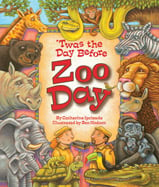Packy, a pack rat, comes home to his mother and sister with a wagon load of items he found. His mother instructs him to sort them out and put them away. Packy marvels at his diverse collection of trinkets and carefully ponders how he will organize them. In rhyming couplets, he reveals the common attributes he finds in groups of items from his treasure. Here is a sneak peak!
The turtle, the clover, the skinny string bean,
he placed in a pile made of things that are…green.
The turtle, the egg, and the acorn that fell,
these are all things with a hard outer…shell.
After going through several possible combinations, he realizes that many of his trinkets have vanished. Baffled, he tells his mom about the missing items. The next page reveals what happened to them!
Evaluation:
Sort It Out is an enjoyable math “mystery.” The first time I read it out loud to my son, I was caught up in the playful rhyme and pleasing text. As a result, the final outcome or “mystery” was a delightful surprise. My son and I went back and re-examined Sherry Rogers’ adorable illustrations to discover the “clues.” I love that multi-dimensional aspect of the book. Barbara Mariconda’s Sort It Out is an ideal set or lead in to a preschool or kindergarten math lesson on sorting. I love the rhyming couplets. Not only do they provide a teaching opportunity in rhyming words and sorting, but also in predicting skills. The final rhyme (and also the way the items are sorted) is not revealed right away. Instead, it is in a little box on the next page. Parents or teachers can cover up the word with a finger or sticky note. Then, allow the child to predict what the word might be. Whether they are correct or not, they are sure to delight in solving the “mystery.”
More Teaching Opportunities:
As with all their amazing books, Sylvan Dell provides an across-the-curriculum teacher’s activity guide as well as other resources on their website, including a preview of this outstanding teaching resource.



















